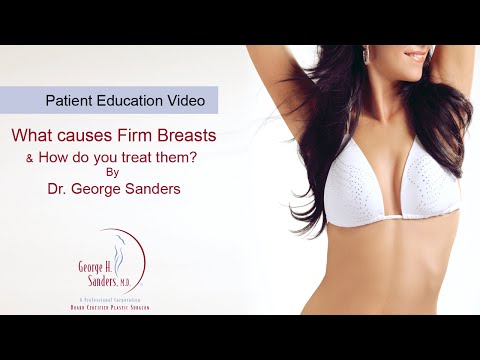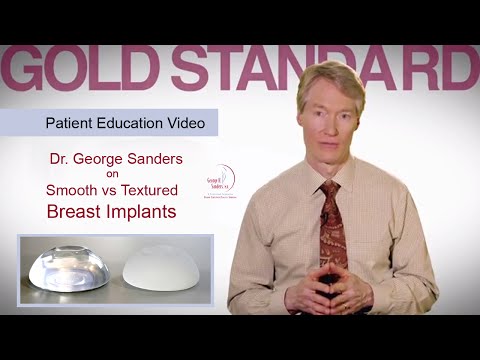Breast Augmentation Topics
Transform your silhouette and boost your confidence with Dr. George Sanders, a distinguished breast augmentation surgeon in Los Angeles. Offering a variety of implant shapes and sizes to cater to your unique needs, Dr. Sanders is committed to helping you achieve the breast size you desire.
Why Women Choose Dr. Sanders for their Breast Augmentation
For the woman who feels her breast size is too small or not properly contoured, cosmetic breast enhancement may be the answer. With years of experience, Dr. Sanders is well known for his excellence in aesthetic breast surgery, including breast augmentation, breast lift and breast reduction. For his breast augmentation patients, he is able to increase size, fullness and elevation while artistically shaping the breast into a natural, pleasing contour. Both saline and silicone implants are available to his patients, and since Dr. Sanders uses the “dual plane” surgery technique, there is usually minimal discomfort after surgery and a reduced recovery time afterwards.

What Patients Are Saying About Us
Good Candidates for Breast Augmentation
Breast Augmentation is a highly individualized procedure. You need to have realistic expectations about the procedure’s outcomes and conduct the necessary research to determine if it is right for you. There are several factors plastic surgeons consider before classifying patients as good candidates for a breast augmentation.
Have Saggy or Droopy Breasts Due to Pregnancy or Breastfeeding:
Dr. Sanders hears from many moms who simply want to look the way they did before they had kids, undoing some of the unwelcome side effects of pregnancy, childbirth, and nursing. In many women, this is largely achievable through breast augmentation.
Are Physically Healthy:
Women who are currently suffering from infections or health conditions that inhibit their ability to heal properly, may not be suitable candidates for breast augmentation. Dr. Sanders and his team will take stock of each patient’s medical history, prioritizing overall health and safety above all else.
Have Breasts That Are Stable in Size:
Women who have experienced fluctuations in their breast volume may not wish to undergo breast augmentation until their size stabilizes. Changes in breast size may occur due to breastfeeding, significant weight loss or weight gain, or medical conditions. Additionally, good candidates for breast surgery have breasts that are fully developed.
Have Breasts That are Dissimilar in Size:
One of the most common reasons to seek breast augmentation is because the breasts are asymmetric in size. If you have one breast that is notably larger than the other, Dr. Sanders can explain your options for achieving a more harmonious, even appearance.
Are At Least 18 Years Old (For Saline Implants):
Dr. Sanders and his team offer different kinds of implants made with different materials; for those who seek saline implants, it is necessary to be at least 18 years of age. This is primarily an issue of FDA compliance though it is also important that women have fully developed breasts when they come in for implants.
Are At Least 22 Years Old (For Silicone Implants):
For patients who want silicone implants, the FDA requires a minimum age of 22. Those who are eager for breast augmentation but are not yet old enough for silicone are encouraged to ask Dr. Sanders about the pros and cons of saline implants.
Before and After Photos
One of the primary goals of breast augmentation is to achieve results that are substantive but also natural-looking. Dr. Sanders and his team help provide this balance and strive to achieve satisfaction with each individual patient. See for yourself what Dr. Sanders can achieve when you review these before and after photos.
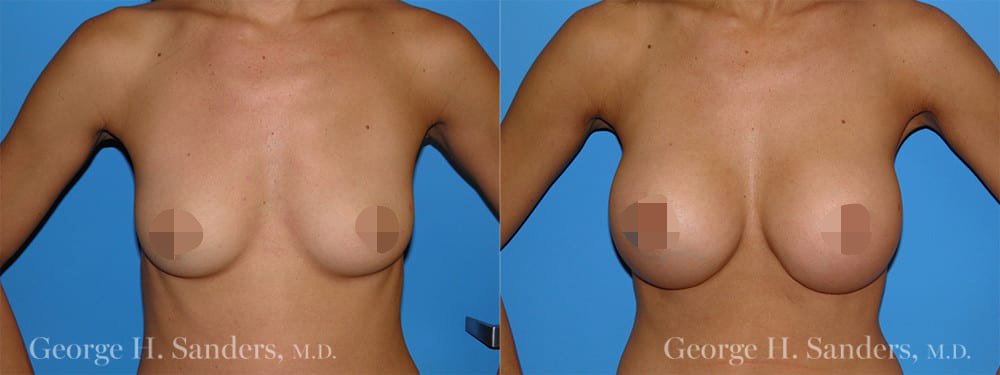
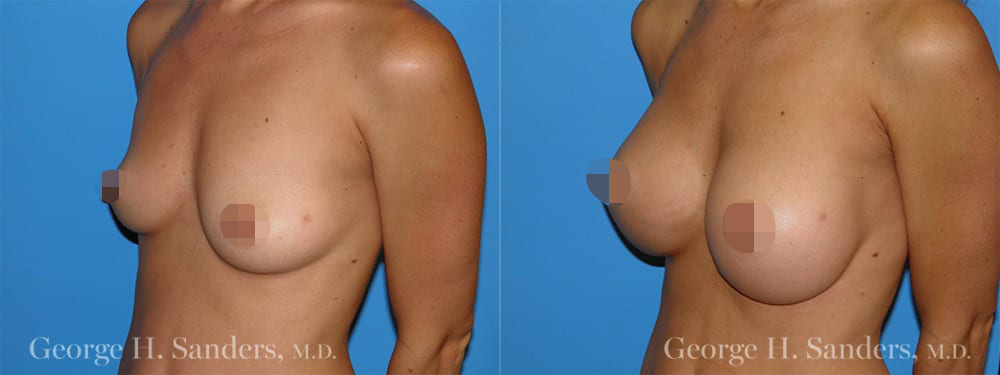
Types of Breast Implants
Each implant type has its own set of benefits and downsides. During your consultation, Dr. Sanders will make sure to take into account your needs and expectations before recommending the right implant type for your body type. Keep reading to learn more about each type.
Saline
Saline implants are available in different shapes and sizes, making it easy for Dr. Sanders to customize an implant to the patient’s needs and goals. Saline implants are empty when inserted into the breast and are then filled with a salt water solution to give them volume. Because of this, saline implants typically allow for smaller surgical incisions.
Silicone
Silicone implants differ from saline implants in that they come pre-filled with a silicone solution; this material is meant to simulate the texture and feel of natural breasts. Some women prefer silicone implants because they offer a more realistic feel and appearance. These implants can require a slightly larger incision and are only available to patients 22 and older.
Smooth
Whether patients choose saline or silicone, they can get their implants with either a smooth or a textured outer shell. Smooth-shelled implants are round in shape and are the more popular of the two options. They wrinkle less than textured implants, which is important for women with small breasts.
Textured
Textured implants are also available with both saline and silicone breasts. These implants have a rougher exterior than their smooth counterparts and are designed to better adhere to the natural breast tissue. As such, textured implants have a slightly lower risk of inadvertent repositioning. Also, textured implants are available in either round or tear-drop shapes. The primary disadvantage is the slight risk of ALCL, a rare lymphoma of the scar tissue surrounding the implant.
Breast Implant Placement Options
Subglandular Approach
With a subglandular approach, implants are placed between the breast tissue and the pectoralis muscle. Some patients prefer this approach because it avoids the animation deformity that occurs with pectoralis muscle contraction, and also because this approach has a shorter recovery time. The downside is that with the implant just below the skin’s surface, it may sometimes appear less natural and there is more visible and palpable wrinkling. The use of natural-looking silicone implants can counter this.
Submuscular Approach
With a submuscular approach, the implants are positioned behind the breast tissue and the pectoral muscle. Some patients find this to be less comfortable, and the recovery time could be longer, but submuscular placement may also result in a more natural-looking end result and better quality of mammograms. The breast tissue and muscle help camouflage the implant, providing a more seamless look.
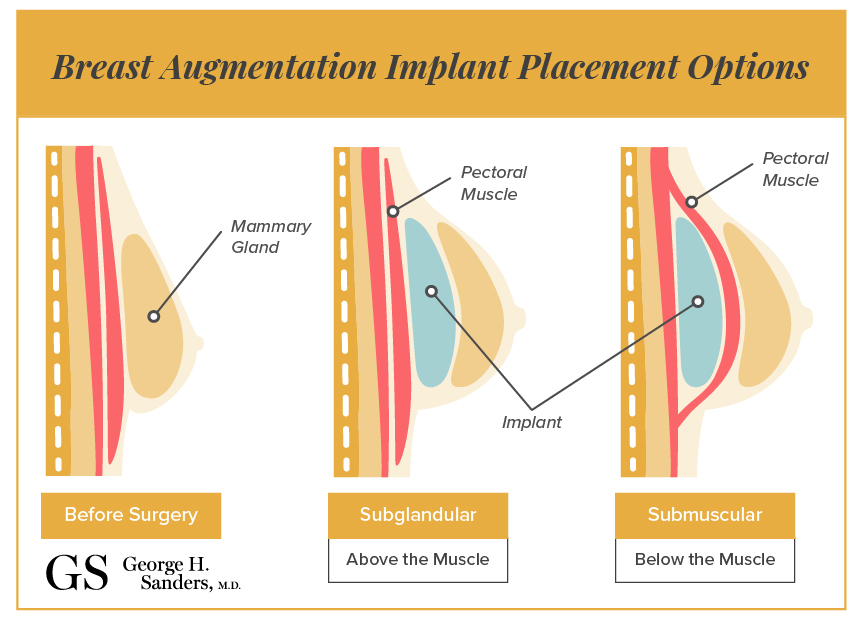
Incision Location Options
Transaxillary
With this approach, Dr. Sanders will create an incision from the armpit to the breasts. Transaxillary incisions allow for the use of an endoscope and may be as small as an inch long. Many patients prefer this approach because the scar is effectively invisible, and because there is no damage done to the areola.
Periareolar
This type of incision is made along the lower border of the areola. The main advantage is that this incision type tends to be a scar that is very well hidden and it may allow for the placement of a larger implant than the inframammary incision.
Inframammary
Inframammary incisions are made along the crease of the breast fold, roughly at the place where the breast and the rib cage meet. Incisions made under the breast fold are not readily visible and provide easier access for Dr. Sanders to place the implant. Inframammary incisions may also be linked with fewer complications such as capsular contracture.
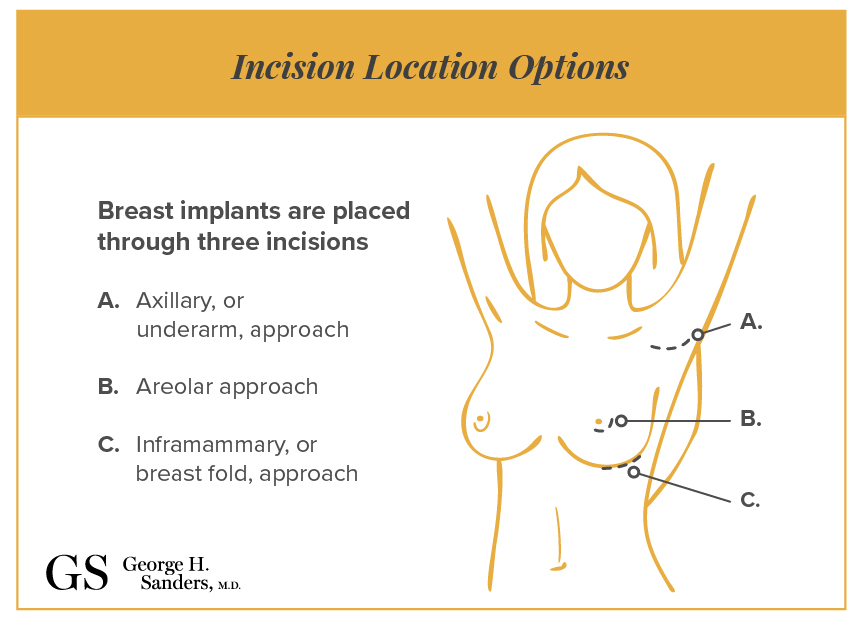
Choosing the Best Breast Implant Option For You
Both silicone and saline implants are available in various sizes and shapes, according to the patient’s personal preference. Both types of implants require minimal incisions, with the silicone implant requiring a slightly longer incision than the saline implant. Both silicone and saline implants can be placed through inframammary (breast fold) or periareolar (along the lower areolar border) incision areas. The incision scars are barely noticeable and easily concealed either just under the areola or by the breast fold. The transaxillary (underarm) approach does not allow for as precise a placement of the implant as do the inframammary or periareolar approaches. For this reason, Dr. Sanders does not favor the transaxillary incision.
Saline and silicone implants each come with two types of outer shells: smooth or textured. Smooth implants, which are round in shape, are the most popular choice of breast implants. Smooth implants are covered in smooth, thin silastic material that gives the breast a soft feeling and produces less wrinkling than do the textured implants. And since smooth implants don’t adhere to the surrounding breast tissue, they move within the breast implant pocket, giving them more natural overall movement than textured implants.
There is also a lower chance of rippling when using smooth implants as opposed to textured, and recovery time for smooth implants may be less than for textured shaped implants. Textured implants have a slightly rough surface designed to cause the implant to adhere to the tissue around it, maintaining their position. Tear drop implants have a textured surface and may be filled with a thicker gel that causes the implant to be “form stable” (meaning that it doesn’t change shape). These implants are used primarily in reconstructive cases or where there is significant tightness in the lower part of the breast. The textured surface prevents rotation of the implant, which is important because of their “tear drop” shape. The incision is larger when placing textured implants, resulting in a longer scar. For the tear drop implant, recovery time is also longer, and the cost of these implants is greater than for smooth implants.
Recently 5th generation silicone gel has become available in all implant types. Although a bit firmer than the 4th generation gel, it ripples less and also maintains more fullness in the upper part of the implant. It may also have a lower leakage rate than the 4th generation gel implants.
Dr. Sanders’ Approach To Breast Augmentation
Dr. Sanders uses the “dual plane” placement method, a method that places the implants partially under the muscle (with the top of the implant under the pectoral muscle and the bottom of the implant in front of the pectoral muscle). This implant placement method provides a more natural slope to the upper part of the breast.
The dual plane method also results in less discomfort than placing the implant completely behind the muscle. Placing the implants behind the muscle as opposed to in front of the muscle also results in a lower risk of capsular contracture (contraction of the scar tissue around the implant, causing breast to harden) and traction rippling (folds or wrinkles in the implant that are visible through the skin) after surgery.
Breast Implants FAQ
-
How much does breast augmentation surgery cost?
The cost of breast augmentation varies, based on the patient’s choice of implants and certain other individual factors, such as their build. Dr. Sanders offers financing options that create an affordable monthly payment method with low to zero interest.
-
Do you offer gummy bear implants?
Yes, Dr. Sanders offers form-stable or gummy bear implants made of a gel-like silicone substance instead of liquid. He provides this option in tear-drop shapes.
-
Can you do a fat transfer instead of using implants for breast augmentation?
Fat transfer does not offer the projected look that most women desire from breast augmentation. It will, however, allow the surgeon to enhance the result of a breast augmentation by providing more cleavage or more upper breast fullness.
-
Are breast implants safe?
Breast implants have been subjected to extensive safety testing and have been widely used for decades. Modern implant technology has led to strong, durable shells that last for many years. While there is a small risk of implant complications, Dr. Sanders is very confident in the safety of the implants he uses.
-
How long do breast implants last?
Breast implants do not need to be replaced unless there is a problem with the implants, such as a leak or scar tissue contracture, or the patient wants to change her breast size. After 25 years there is an approximate 50-50 chance that one of the implants is leaking.
-
How do I know if my implant ruptures?
If a saline implant ruptures, the breast looks smaller and flatter almost immediately. It is more difficult to detect a silicone implant rupture because the gel tends to remain in the breast implant pocket. MRI’s are recommended every 3-5 years to check the integrity of silicone implants. If there is no leak, no treatment is required.
-
How do I know if I need a breast lift in addition to breast implants?
Whether you need a breast lift depends on how much your breasts sag and where your nipple sits on the breast. If your nipple falls below the crease of your breast, it is likely you would benefit from breast lift in combination with your implants. Dr. Sanders can give you more information at your consultation.
-
How Can Breast Augmentation Correct Tuberous Breasts?
Tuberous breasts are a problem women across the Los Angeles area experience. Women with tuberous breasts may have sagging, a wide space between the breasts, a higher-than-normal fold beneath the breasts, a pushing out of the breast into the areola, and larger-than-normal areolas. In many cases, the breasts are also asymmetrical. Breast augmentation combined with a circle lift is usually quite effective in fixing this problem in one single surgery. During the procedure, Dr. Sanders will release breast tissue that’s restricting the breasts, place implants to fill out the breasts, and then perform a circle lift that allows a reduction of the areolar size, a repositioning of the breast tissue that is pushing out through the areola, and a lifting of the areola The only scar produced is one around the areola that is usually minimally detectable. If women do require a second surgery, it’s usually to give the breast tissue time to expand so there’s room for a larger implant.
-
Can Breast Implants Help Breasts Look Perkier?
Breast implants can improve the perkiness of sagging breasts to a degree. In many cases, however, Los Angeles patients with sagging breasts may be better suited for a breast lift instead. Breast implants are a great tool for improving the fullness of the breasts, but unfortunately, they don’t do much to push the breast upward. While the implant may create more fullness in the top of the breast, the rest of the breast may continue to sag, especially because of the added weight of the implant. A breast lift both lifts and pulls the skin of the breast tight and restores a more youthful silhouette. To get the best of both worlds, many women opt for a combination procedure that both improves the size and lift of their breasts.
-
What Is the Best Implant Shape?
There is no best implant shape; rather, it all depends on the preferences of the patient. The two main shapes women have to choose from are round and teardrop.
- Round implants are round in shape, and have varying degrees of projection, ranging from low profile to high profile.
- Teardrop implants are shaped like a teardrop, being quite projecting in their lower part and less so in their upper part. One major disadvantage to the teardrop shaped implants, however, is that they must be of a textured surface. This textured surface is associated with ALCL, a rare lymphoma of the scar tissue surrounding the implant. This problem does not seem to be present with smooth implants, making round implants the overwhelming choice for the vast majority of patients.
-
How long do the results of a breast augmentation last?
Most people do not need to replace their implants for many years since there is only a 50/50 chance that one of the implants will leak after 25 years.
Recovering from Surgery
After breast augmentation surgery, patients can typically return to normal activities almost immediately. Cardiovascular exercise may be resumed 2 weeks after surgery and strength training/stretches/yoga restarted 4 weeks after surgery. Drainage tubes are rarely used during recovery, minimizing discomfort in the recovery process. And since the breast implants will naturally settle over time, there is usually not a need to push them down with a strap across the upper chest after surgery.
Excellence in Breast Augmentation in Los Angeles
Dr. Sanders’ decades of experience and his dual-plane method for placing implants make him a leading specialist in cosmetic surgery. With a board-certified plastic surgeon like him at your side, you can get the lasting breast augmentation results you have always wanted. For more information on how to get started, please contact Dr. Sanders’ Los Angeles office to schedule a consultation.
